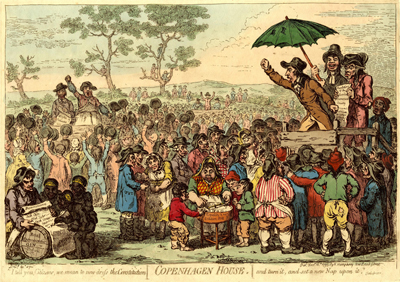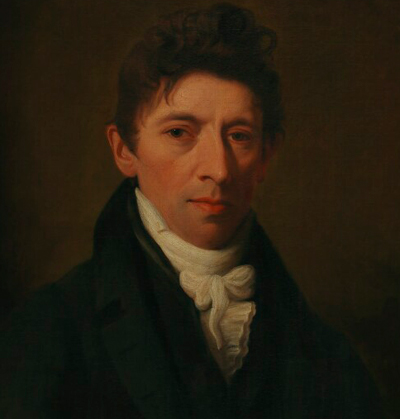Copenhagen House
This print is a reasonably accurate (and not unsympathetic) conflation of two meetings organized by the London Corresponding Society that took place in the fields behind Coperhagen House in the rural retreat of Islington on October 26 and November 12, 1795. It was a terrible time for the country with military losses abroad and poor harvests and bread riots at home. Even religious crackpots like Richard Brothers, the Prophet of the Hebrews, gained followings because he seemed to offer hope or at least an explanation for the prevailing misery felt by the poor and working classes.
Estimated to have been attended by fifty to one hundred thousand mostly working class citizens, the Corresponding Society general meetings were designed to address those ills through legislative reform. Not surprisingly given the sheer size of the crowds, the organizers needed to provide multiple tribunes (speaker's platforms) from which the same message could be simultaneously conveyed to the huge audience. As shown in Gillray's print, at least three tribunes seem to have been erected in both cases. The principal speakers were John Thelwall (right foreground), Richard Hodgson (on the left), and John Gale Jones in the middle background with his arms upraised.

© Trustees of the British Museum
There is some dispute about the identification of Hodgson and the depiction of Hodgson and Gale Jones in Gillray's print. There are two R. Hodgsons listed as part of the London Corresponding Society in an announcement printed in the Morning Post and Fashionable World for June 23, 1795: one a "Grocer, opposite the Gun Tavern Lambeth Road;" the other a "Hatter, No. 10 Broadway Westminster." And the Oxford Dictionary of National Biography lists a William Hodgson, physician, as also part of the London Corresponding Society at that time. So there are (at least) three possibile identifications for Hodgson in Gillray's print. The British Museum commentary identifies Gale Jones as the burly man on the tribune to the left. But a roughly contemporary (1798) portrait of Jones in the National Portrait Gallery shows a slight, young figure consistent with the slimmer speaker with his arms upraised in the background. So I am assuming the speaker in the center background is intended for Jones.
What is indisputable is the identification of John Thelwall, well-known for his provocative lectures which had already prompted his arrest for high treason in 1794 along with Thomas Hardy and John Horne Tooke. Accounts of the gathering specifically mention him haranguing the multitude, as Gillray shows him with his fist clenched and arm upraised. Gillray's caricature bears some resemblance to a later painting of Thelwall attributed to John Hazlitt.

© National Portrait Gallery, London
The October 26 general meeting was designed to gain approval for an "intended Address to the Nation on the state of public affairs," (in this case 'on the dearness of the necessaries of life') a "Remonstrance to the King" for ignoring an earlier petition in June, and "several resolutions for a Parliamentary Reform, by universal suffrage, and annual Parliaments." Gillray picks up on some of these details in the list labeled "Resolutions of the London Corresponding Society" held by the young barber/hairdresser standing behind Thelwall; and on the opposite side of the print where a scroll labeled "Remonstrance." is being signed by three chimney sweeps.
Anticipating mischaracterization by the Ministry press, the organizers seem to have gone to some lengths to emphasize that all protests should remain peaceful. In the advertisement for the general meeting which appeared in the Morning Chronicle for October 22, for instance, potential attendees were asked
to exert their usual efforts with strangers to preserve that order and decorum which has, upon similar occasions, placed this Society and its proceeding above the reach of slander, and the intrigues of the enemies to Parliamentary Reform.
And by all accounts the meeting succeeded in its business of gaining support for the proposed actions of the Society and according to the November 1st London Free Mason Magazine "When the evening approached, the whole peaceably dispersed."
Unfortunately, a few days later, on October 29th, the King's carriage was attacked twice on its way to and from Parliament by rock-throwing crowds demanding bread and peace with France. The episode was portrayed by Gillray with even-handed satire in The Republican Attack. Unfortunately, the assault on the King and the size of the protests now being assembled by groups like the Corresponding Society led almost immediately to the introduction of further repressive measures from the Pitt government in the form of the Treasonable Practices and Seditious Meetings Acts.
As a result, a second general meeting similar to the first was called by the Corresponding Society for November 12. This time the petitions, addressed to King and both houses of Parliament, protested what they considered attacks upon "Magna Charta" and their rights as native English citizens. Here is an excerpt from the Morning Post and Fashionable World for November 13.
In the Field, there were three TRIBUNES, erected at convenient distances, forming a triangle, for the accommodation of the Speakers. Among those who distinguished themselves were Messrs THELWALL, HODGSON, and JONES. Each Speaker, to prevent a waste of time, spoke to the same points point at the same time to a different audience for the purpose of elucidating the Outrage offered to the Liberties of Englishmen, in the present measures introduced in Parliament by His Majesty's Ministers, and which agitate the feelings of the Country at large, as much as they have engaged the Patriotic eloquence, and excited the Constitutional resistance of the gentlemen denominated the OPPOSITION, in both Houses of Parliament.*
Gillray's print was probably begun sometime after the first general meeting on October 26 and before the second on November 11. I say that because the only clear references to the second meeting are an oddly located label on the EO wheel in the central foreground: "Equality & no Sedition Bill" and a scroll inscribed with with "Rights of Citizens"—both of which look to have been added after the fact as a way of broadening the print's application.
Commentators have noticed that, as an outdoor crowd scene, the print owes a general debt to Hogarth in plates like The Idle 'Prentice Executed at Tyburn (1747), and to Rowlandson in show pieces like George III and Queen Charlotte driving through Deptford (1785). But what a difference! The Hogarth and Rowlandson scenes are crammed with individual activities that have nothing to do with the actual occasion and which are both celebrated and deplored as instances of the the individualism permitted by the English commitment to personal liberty. Gillray's, on the other hand, is an ORGANIZED, not an unruly, crowd of poor, mostly trades people, listening to the speeches being delivered by the representatives of the Correponding Society. The only other parallel activities shown are the chimney sweeps signing the petition, a woman pouring drinks (gin?), and the small group playing EO.
Gillray's perspective on all this is, not surprisingly, complex. The cask of " Real Democratic GIN by Thelwall & Co." which he includes in left front corner of the print recalls another Hogarth plate, Gin Lane where gin is portrayed the ultimate destroyer of the working class. The labeled cask suggests that the speeches of Thelwall and the London Corresponding Society may be intoxicating, but leave the working class with a considerable hangover. And the fact that the names appearing on the scroll above the cask are all (failed) revolutionaries may confirm that the sweeps and the other working class figures populating the print do not fully understand what they are signing up for.
But though Gillray may be critical of the ring leaders of the London Corresponding Society, he seems sympathetic to the crowd of men and women gathered in the open fields. These are not criminals, potential traitors, itching to overthrow the government. In fact, the print is conspicuous in the complete absence of violence, criminal activity, or French revolutionary symbols. What we see is a democratic process at work in which equal participants listen to the draft petitions and indicate their vote of yea or nay by peacefully raising a hat or a handkerchief. Indeed it is almlost idyllic when contrasted with the violence and ouright corruption shown in prints like Butchers of Freedom and Election Troops Bringing in their Accounts to the Pay Table (both 1788) where Gillray portrays the established electoral process.
The print contains a caption derived from Henry VI Part II Act IV Scene 2 which, I think, we are to take as coming from the mouth of Thelwall. "I tell you, Citizens, we mean to new dress the Constitution, and turn it, and put a new nap upon it. Taken alone, it sounds like Gillray's earlier Fashion Before Ease, or a Good Constitution Sacrificed for a Fantastick Form (1793) where constitutional reform is clearly a bad idea. But when we follow Gillray's direction "Vide Shakespeare" and look at the larger passage from which the caption is derived, we may come away with a slightly different and more balanced reading of Gillray's intent.
BEVIS
I tell thee, Jack Cade the clothier means to dress
the commonwealth, and turn it, and set a new nap upon it.
HOLLAND
So he had need, for 'tis threadbare. Well, I say it
was never a merry world in England since gentlemen came up.
BEVIS
O miserable age! virtue is not regarded in handicrafts-men.
* I have included a reproduction of the article as well as the three petitions.
Sources and Reading
- Commentary from the British Museum on Copenhagen House.
- Diana Donald, The Age of Caricature, 1996, p. 140
- Draper Hill, The Satirical Etchings of James Gillray, 1976, #37
- "London Corresponding Society," Wikipedia
- "Jack Cade's Rebellion," Wikipedia
- "John Thelwall," Wikipedia
- "John Gale Jones," Wikipedia
- "Jack Straw (rebel leader)," Wikipedia
- "Wat Tyler," Wikipedia
- "Beer Street and Gin Lane," Wikipedia
- Thomas Wright and R.H. Evans, Historical and Descriptive Account of the Caricatures of James Gillray #134.
- Thomas Wright and Joseph Grego, The Works of James Gillray, the Caricaturist; With the History of His Life and Times, p. 193.
Comments & Corrections
NOTE: Comments and/or corrections are always appreciated. To make that easier, I have included a form below that you can use. I promise never to share any of the info provided without your express permission.